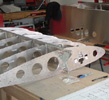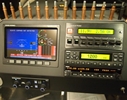


random user submitted photo
Leading edge dimple die
16 posts
• Page 1 of 2 • 1, 2
Leading edge dimple die
I am kicking into high gear on my Sonex kit, and having a blast at it! I am currently drilling my wing skins. Looking forward to my leading edge wing skins I know I will need a Sonex dimple die. If anyone has one laying around, I will pay for shipping both ways.
For all the most recent news and pictures of my build y'all can visit my blog isaacshultzsonex.blogger.com
Thanks,
For all the most recent news and pictures of my build y'all can visit my blog isaacshultzsonex.blogger.com
Thanks,
-Isaac Shultz
- Issak
- Posts: 7
- Joined: Sat Oct 22, 2016 2:30 pm
Re: Leading edge dimple die
Issak wrote:I am kicking into high gear on my Sonex kit, and having a blast at it! I am currently drilling my wing skins. Looking forward to my leading edge wing skins I know I will need a Sonex dimple die. If anyone has one laying around, I will pay for shipping both ways.
For all the most recent news and pictures of my build y'all can visit my blog isaacshultzsonex.blogger.com
Thanks,
http://isaacshultzsonex.blogspot.com/
- mike20sm
- Posts: 88
- Joined: Tue Dec 02, 2014 9:32 pm
- Location: Southern California
Re: Leading edge dimple die
Any thoughts on the Simple Dimple die vs. the Cleveland version? I seem to recall reading less than ideal feedback on Sonex's dies.
http://www.cleavelandtool.com/3_32-Clos ... UlIve3ytpg
http://www.cleavelandtool.com/3_32-Clos ... UlIve3ytpg
C150 driver by day, OneX 204 builder by night.
Empennage done, fuselage in work...
Empennage done, fuselage in work...
- N814W
- Posts: 40
- Joined: Tue Apr 08, 2014 11:55 pm
Re: Leading edge dimple die
N814W wrote:Any thoughts on the Simple Dimple die vs. the Cleveland version? I seem to recall reading less than ideal feedback on Sonex's dies.
http://www.cleavelandtool.com/3_32-Clos ... UlIve3ytpg
I like all of the Cleaveland Tool products I've had over the years of my Sonex build. Having said that, I should point out that no "nail and die" tool will give you perfect dimples (like a rivet squeezer or a C-Frame will)... So its not like the Cleaveland die gives you an amazing result and the Sonex tool is crap; its that the Cleaveland Tool dies give you _relatively_ better results. If you already have a couple of the Sonex dimple-die tools they're likely to be good enough for you. If you haven't purchased anything yet, then I'd go with the Cleaveland Tool units myself.
Good luck,
--Noel
Sonex #1339
- NWade
- Posts: 527
- Joined: Mon Aug 08, 2011 3:58 pm
Re: Leading edge dimple die
Just thought I'd mention for new builders who may have missed the age old posts on this. Dimpling does enlarge the hole so best to do so at 3/32 or 7/64. If I recall dimpling at 7/64 will bring the hole to #30. There were some stories long ago of rivets pulling through from dimpling at #30
Darrell Frey
N265DF reserved. For a story on the N number, 265 is the serial #, 65 was my age when purchased plans. DF is my initials
Darrell Frey
N265DF reserved. For a story on the N number, 265 is the serial #, 65 was my age when purchased plans. DF is my initials
- N265DF
- Posts: 13
- Joined: Mon Nov 24, 2014 2:15 pm
Re: Leading edge dimple die
N265DF wrote:Just thought I'd mention for new builders who may have missed the age old posts on this. Dimpling does enlarge the hole so best to do so at 3/32 or 7/64. If I recall dimpling at 7/64 will bring the hole to #30. There were some stories long ago of rivets pulling through from dimpling at #30
I can provide clarification on that (partly because I was around 8-9 years ago when lots of discussions were going on about it, and partly because I've done my own tests with my all-flush-pulled-rivets Sonex build)...
For the best results with a dimpled rivet, pilot-drill with a #40 bit and then up-drill with a #32 bit. Then deburr, then dimple. Voila! Perfect hole. There are two issues with this method, however:
- Brass clecos (designed for #30 holes) will not fit very well into #32 holes. Don't be surprised if they're stiff to get through and retract; and they may slightly elongate the holes in the process (though the hole returns to round once you dimple it).
- If the hole goes through a thick piece of material (some aluminum angle-stock or the spar cap, for example), then you cannot leave the thick material drilled with a #32 hole. After you disassemble the parts, you need to do a final up-drill of the thick item with a #30 bit, and counter-sink as appropriate.
Now, if you are careful and do not over-drill or overly-deburr your holes, a #30 drill bit can be used on skins & ribs prior to dimpling. People have performed tests and found that the resulting assemblies are still reasonably strong. However, you do run the risk of the occasional rivet pulling so far that the stem breaks off proud of the rivet head. The general consensus is that a couple of these spread out across a part are not going to seriously weaken the part. But if you have several rivets exhibit that behavior, your holes are getting too big and you need to drill them out and replace them with up-sized rivets.
Enjoy,
--Noel
Sonex #1339
- NWade
- Posts: 527
- Joined: Mon Aug 08, 2011 3:58 pm
Re: Leading edge dimple die
I wrote an artical for the Australian Sonex Owners on the Simple Dimple Die some time ago, below is a link.
https://sonexaus.wikispaces.com/Dimpling
https://sonexaus.wikispaces.com/Dimpling
Peter Henry
W#149
W#149
-

phenry - Posts: 60
- Joined: Tue Nov 22, 2011 11:29 pm
- Location: Newborough Vic. Australia
Re: Leading edge dimple die
Hi all,
I've mentioned this before, but putting this out there for new folks. Cleveland aircraft tools has a special dimple die 'dienq' part number, for the dimpleing . Especially for sonex and panther kits. Drill a #40 hole, you can still use 3/32 clecoes, dimple, ream with a #30 drill for a perfect fit. Check it out.
WaiexN143NM
Michael
I've mentioned this before, but putting this out there for new folks. Cleveland aircraft tools has a special dimple die 'dienq' part number, for the dimpleing . Especially for sonex and panther kits. Drill a #40 hole, you can still use 3/32 clecoes, dimple, ream with a #30 drill for a perfect fit. Check it out.
WaiexN143NM
Michael
- WaiexN143NM
- Posts: 1206
- Joined: Mon Sep 15, 2014 1:04 am
- Location: palm springs CA
Re: Leading edge dimple die
For what its worth, I did have problem with Sonex dimple die, but that was 6 years ago and would hope they have changed it by now. Problem was too steep a nose angle (about 80 degrees) into a female die of about 100 degrees which over stretched the material opening the a # 32 (0.116") drilled hole to about 0.140" , which is way too big. Looked at the 3/32" die I got from Avery Tool, which worked fine, and made new 1/8" die set on lathe with similar angles. I used a common 118 degree drill bit to form the concave half of the die and made the nose 115 degrees. Used in holes drilled with #32 bit, and opened to nicely hold 1/8" Clecos and rivets. Still have the drawing for that if anyone wants it. Used with common nail for mandrel but do need to cleanup usual burr under the head before use.
David A.
David A.
- DCASonex
- Posts: 935
- Joined: Mon Sep 12, 2011 8:04 pm
- Location: Western NY USA
16 posts
• Page 1 of 2 • 1, 2
Who is online
Users browsing this forum: No registered users and 66 guests







